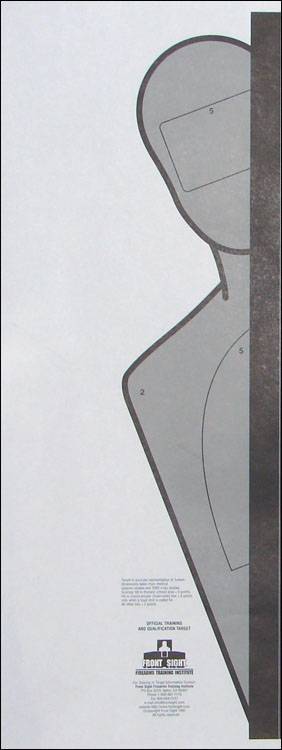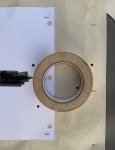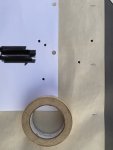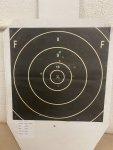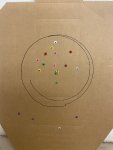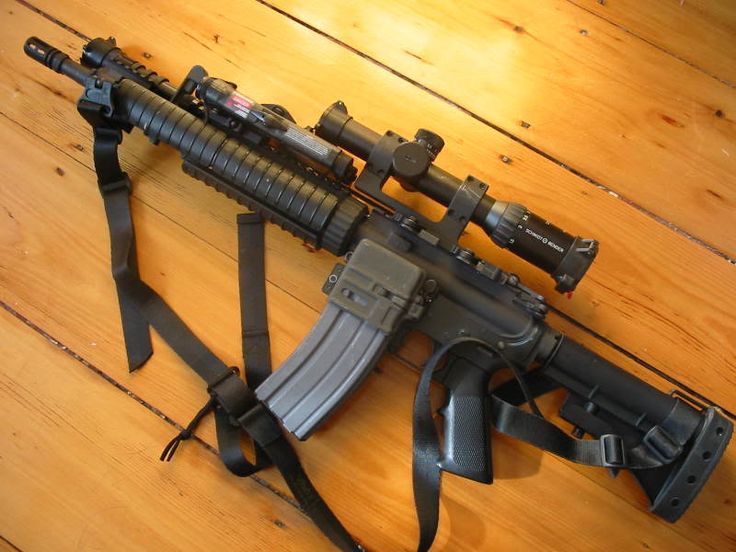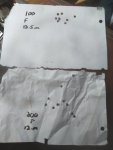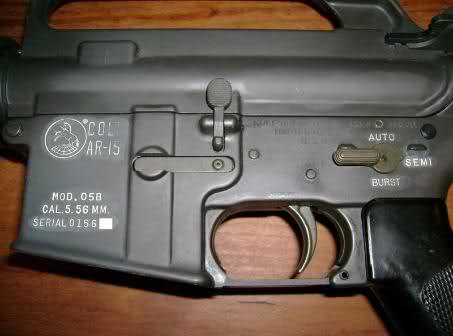I have seen some of those rifles, I did not know it was the first. I’m no history expert but I do do a little.
I don’t think a free float rail is absolutely necessary for a service rifle but these days it’s dumb not to have one, imho!
if I were to own any rifles they are all free float, or would be I should say. I don’t own any evil assault rifles

I really like the 605. I personally haven’t had any issues with reliability, but my barrel is a bit longer. Most of the parts on mine are original, including the Bolt Carrier (Colt pre-1964 slick chromed). Lower is NoDak repro partial fence.
As far as zeros and sighting goes, it of course has the full-length sight radius of a rifle and no real practical change in ballistics.
Speaking of fire control groups, they had two variants, the 605A and 605B. 605B had SAFE, AUTO, SEMI, BURST 4-way selector with a cutout under the selector lever so it could bypass the integral quarter sphere stops:
On the 300m zero: There was a different thought process in the 1950s when the Army took a radical departure from its previous, comprehensive rifle marksmanship program of the 1920s-late 1940s. The previous rifle marksmanship program involved a 2-week intensive shooting package with all kinds of ranges, stages of fire, and positional shooting. It included walking combat lanes with pop-out targets, shooting from ditches, windows, roofs, rubble piles, simulated blown-up walls, from behind log piles, and long range engagement of men and vehicles out to 500, 600, and 800yds.
With the advent of the nuclear era and nuclear-focus, someone figured we wouldn’t need riflemen that much anymore, other than the Fulda Gap and the Northwest Corridor of the Korean DMZ, so they dumbed everything down into what was called “Train Fire”. Train Fire was basically conscript-level marksmanship and qualification, but with a cool pop-up target range that went out to 300m.
It was totally defensive-oriented with 2 primary scenarios based on the overall strategy. US soldiers would be holed-up in their fighting positions, a last line of defense in the event of Soviet or North Korean APCs having penetrated our anti-vehicle defenses. As the motorized infantry dismounts would spill out and begin the final phase of their assault after echelons of indirect fire, they would be engaged by machine-guns and rifles from men in their fighting positions.
In the event of certain positions being overrun, soldiers would bound to their supplemental positions and engage from the prone position.
From all the research I’ve been able to do on the changes to the MTO&E and thinking behind Infantry tactics over the last century, this is where you find the "foxhole-supported" and “prone-unsupported” positions becoming the emphasis in the Army’s Train Fire. Gone were all the battle-focused lanes and 2-week marksmanship packages that actually prepared a rifleman for practical shooting with high round-counts and lots of professional instruction, coaching, and feedback.
Since rifle fire was seen as the last resort in an overall organization perspective (aside from being overrun and using personal defense weapons/bayonets/sidearms), it really covers that 300m-and-in distance. This could be why the bean-counters mandated the "25/300m” zero. If someone who has done more research than I have can provide more insight into that, I would be interested.
It does really invalidate the 25m zero from a practical perspective though, considering the types of conflicts we have fought, ever since the nuclear era forced out adversaries to use asymmetric wars, where riflemen go from inconsequential...to critical in effecting the strategy for dealing with a mix of insurgents, surrogates, some uniformed soldiers, and guerrillas. You really need marksmanship more than ever, but the US Army did the opposite and shut down that focus that was there in the Two Great Wars. Some trickled into Korea, but Train Fire really killed it from an organizational perspective, outside of the AMU and a few units.
This new Army Marksmanship training program with the positional shooting, mag changes, and more practical scenarios is a nice start. I’m not sure if they’re doing 2-week marksmanship packages though. Given the current weapons and optics, there is an opportunity to have a much better shooter who has a higher hit probability on select targets in a high civilian-populated environment, with minimal collateral effects.
The 25m and 36yd zeros are not ideal for that. They both increase errant shots that instead of going into the intended target, go somewhere else, including the local populace’s families, vehicles, homes, or friendly personnel. Something to think about that might be relevant here as well, God forbid.
_front_sight_cover_target_01_resized_1_1726875.jpeg)
_front_sight_cover_target_01_resized_1_1726875(1).jpeg)
_front_sight_cover_target_01_resized_1_1726875.jpeg)
_front_sight_cover_target_01_resized_1_1726875(1).jpeg)

